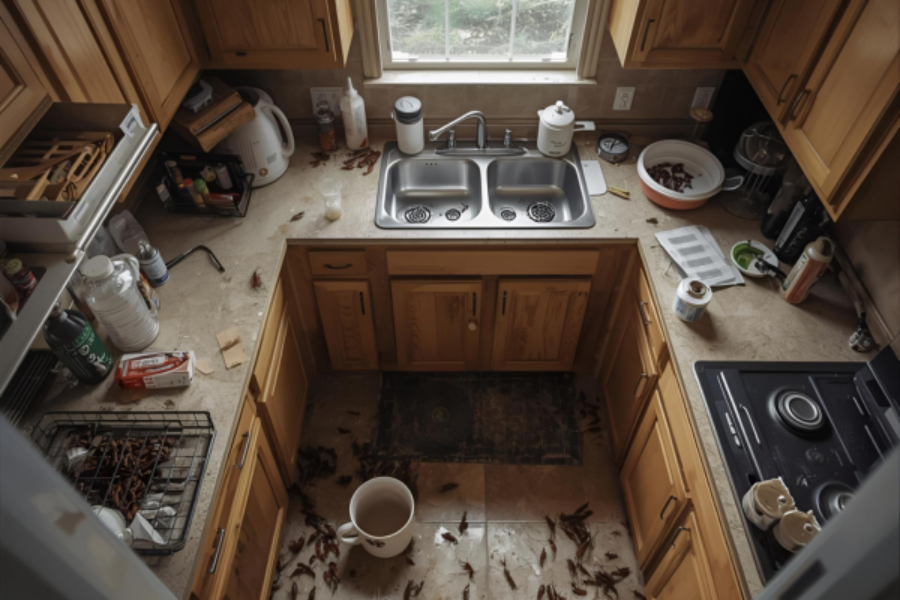Roaches in kitchen cabinets are a nightmare for homeowners. These unwelcome guests not only disrupt your peace of mind but also pose serious health risks. A kitchen is supposed to be a clean, safe space where food is prepared, but when roaches invade, it can feel like a constant battle. Not only do they contaminate your food, but they also leave behind waste, which can contribute to allergies and trigger asthma. If you’re facing a roach infestation in your kitchen cabinets, the good news is that you’re not alone—and it’s a problem that can be fixed.
In this blog post, we’ll explore simple yet effective methods to help you get rid of roaches in your kitchen cabinets, restore your kitchen’s cleanliness, and keep roaches away for good. With a combination of thorough cleaning, natural remedies, and strategic pest control, you can reclaim your space and create a roach-free environment.
Why Roaches Invade Kitchen Cabinets
Understanding why roaches are attracted to your kitchen cabinets is the first step in eliminating them. Roaches are opportunistic creatures that thrive in environments that offer food, moisture, warmth, and shelter. Here’s why your kitchen cabinets might be their preferred hangout.
Roaches Are Attracted to Food and Water Sources
Your kitchen is a prime spot for roaches. The warm environment, Cleaning Guide for Home & Kitchen coupled with easy access to food crumbs, spills, and even food residue, is a feast for them. Crumbs on shelves or inside food packages that aren’t sealed properly provide the perfect snacks for these pests. Even if you’re diligent about cleaning up spills, tiny crumbs can slip through unnoticed, creating a constant food source for roaches.
Warmth and Shelter
Roaches are nocturnal and seek out dark, warm spaces where they can hide during the day. Kitchen cabinets, especially those located near appliances or pipes, offer the perfect hiding places. The warmth from dishwashers, refrigerators, and other kitchen appliances makes these cabinets even more attractive to roaches, giving them both shelter and a cozy environment.
Common Places Roaches Hide in Kitchen Cabinets
Roaches love hiding behind or inside appliances, in cracks or crevices, and underneath shelves. They prefer areas that are not disturbed frequently, so you might not notice them right away. They can easily squeeze into the tiniest cracks, making it challenging to spot them unless you’re looking closely.
Signs You Have Roaches in Your Kitchen Cabinets
Before you dive into action, it’s important to confirm that you have an infestation. Roaches are sneaky, and spotting the signs early can help you take swift action.
Sightings of Roaches
Seeing a roach scurry across your kitchen floor or inside your cabinets is a clear indication of an infestation. If you’re seeing them during the day, it likely means the infestation is significant. Roaches are nocturnal, so daytime activity often signals a larger problem.
Roach Droppings and Egg Casings
Roach droppings resemble small black specks that look like ground pepper or coffee grounds. These are often found in hidden areas, like cabinet shelves or cracks. You might also come across egg casings (called oothecae), which are brown, leathery cases that contain several dozen eggs. Both are telltale signs of a roach problem.
Unpleasant Odor
Roaches emit a musty, oily odor, which becomes more noticeable as the infestation grows. The oils and pheromones cause this scent they secrete. If you detect a strange smell coming from your cabinets or the kitchen area, it’s a sign that you need to act fast.
Step-by-Step Guide on How to Get Rid of Roaches in Kitchen Cabinets
Now that you’ve identified the issue, it’s time to take action. Here’s a step-by-step guide to help you eliminate roaches in your kitchen cabinets.
Step 1: Empty and Clean Your Cabinets Thoroughly
The first step is to empty out your kitchen cabinets. Remove all food items, dishes, and other items. Clean all surfaces with warm, soapy water, and use a vacuum to pick up crumbs and debris from the shelves. Pay attention to the corners, edges, and behind appliances, where roaches love to hide. Make sure to clean all containers before returning them to the cabinets to ensure you don’t reintroduce roaches.
Step 2: Inspect for Signs of Infestation
After clearing your cabinets, carefully inspect them for signs of infestation. Look for cracks, gaps, or damaged areas where roaches may be entering. Check inside and around appliances, behind shelves, and along the edges of cabinets for any droppings, egg cases, or live roaches.
Step 3: Seal Entry Points
To prevent roaches from returning, seal any cracks or gaps you find during the inspection. Use caulk to fill in small holes, and if you notice gaps around plumbing pipes, apply weather stripping around cabinet doors to eliminate any potential entry points.
Step 4: Use Roach Baits and Traps
Roach baits and traps are effective tools for eliminating roaches. Roach baits attract pests, which then eat the bait and return to their hiding places, where they die and decompose. Place baits in areas where roaches are likely to pass, such as behind appliances and inside cabinets. You can use gel baits, bait stations, or natural alternatives like boric acid.
Step 5: Apply Natural or Chemical Roach Repellents
Natural repellents, like essential oils (peppermint, eucalyptus, or tea tree), can keep roaches at bay. You can mix a few drops of oil with water in a spray bottle and apply it to areas where roaches are known to frequent. Alternatively, diatomaceous earth (a fine powder made from fossilized algae) is another natural option. It works by dehydrating the roaches when they come into contact with it.
If the natural methods aren’t enough, consider chemical options like roach sprays or insecticide dusts. These products can kill roaches on contact and help control larger infestations. Always follow the manufacturer’s instructions when using chemical repellents.
Step 6: Regularly Monitor and Clean
After taking the steps above, it’s crucial to continue monitoring your cabinets for new roach activity. Roaches can return if you don’t stay vigilant. Regularly inspect your cabinets, keep them clean, and replace baits as needed.
Preventing Future Roach Infestations in Kitchen Cabinets
The best way to deal with roaches is to prevent them from returning in the first place. Once you’ve eliminated the current infestation, take these steps to keep your kitchen roach-free.
Proper Food Storage
Store food in sealed containers, especially pantry items like flour, sugar, and cereals. Roaches are highly attracted to food, and airtight containers will make it harder for them to access these food sources. Keep trash bins tightly closed as well.
Regular Cleaning Habits
Roaches are attracted to food and moisture, so cleaning up crumbs and spills immediately is essential. Make a habit of wiping down your kitchen surfaces every day, and regularly clean behind appliances to avoid leaving any food behind.
Routine Pest Control
Even if you don’t have an active infestation, regular pest control measures can help prevent future problems. Set up a routine to inspect and clean your kitchen periodically, and if necessary, use natural repellents to keep roaches at bay.
When to Call a Professional Exterminator
Sometimes, despite your best efforts, a roach infestation can get out of hand. In such cases, calling a professional exterminator may be the best solution.
Persistent Infestation
If DIY methods aren’t enough, or the infestation continues to spread, it might be time to call in the experts. A professional exterminator has access to stronger treatments and can help eradicate the problem more efficiently.
Large or Hidden Infestations
If you suspect that roaches are hiding deep inside your walls or other hard-to-reach places, a pest control expert can locate and treat the source of the infestation.
Health Concerns
Roaches can exacerbate allergies and respiratory issues. If you or a family member is experiencing health problems due to the infestation, it’s time to call a professional to ensure the roaches are completely eradicated.
FAQ Section
Q1: What causes roaches to appear in kitchen cabinets?
Roaches are drawn to food, moisture, warmth, and dark hiding spots, all of which can be found in kitchen cabinets.
Q2: Can I get rid of roaches in my kitchen without using chemicals?
Yes, natural remedies like essential oils, diatomaceous earth, and cleanliness can help repel and eliminate roaches without chemicals.
Q3: How long does it take to get rid of roaches in kitchen cabinets?
Depending on the extent of the infestation, it may take a few days to a couple of weeks to completely eliminate roaches using DIY methods.
Q4: Are there any natural remedies to repel roaches from my kitchen cabinets?
Yes, using essential oils like peppermint, tea tree, or eucalyptus oils, as well as diatomaceous earth, can be effective.
Q5: How can I tell if my kitchen has a large roach infestation?
Large infestations often show more frequent sightings, large amounts of droppings, and strong odors. You may also find many egg cases.
Q6: Will cleaning my kitchen cabinets help get rid of roaches?
Yes, cleaning is crucial in removing food sources and debris that attract roaches. It also allows you to spot and address any hidden roaches.
Conclusion
Getting rid of roaches in your kitchen cabinets doesn’t have to be a difficult task. By identifying the problem, taking action with thorough cleaning, sealing entry points, and using baits or repellents, you can easily eliminate an infestation. Keeping your kitchen clean and preventing food access are essential steps in ensuring roaches don’t return. However, if the infestation persists, don’t hesitate to call a professional exterminator to help restore your kitchen to its roach-free state.
With these steps, you’ll not only have a roach-free kitchen but also a healthier, cleaner environment for your family to enjoy. Don’t wait—take action today to reclaim your kitchen!

